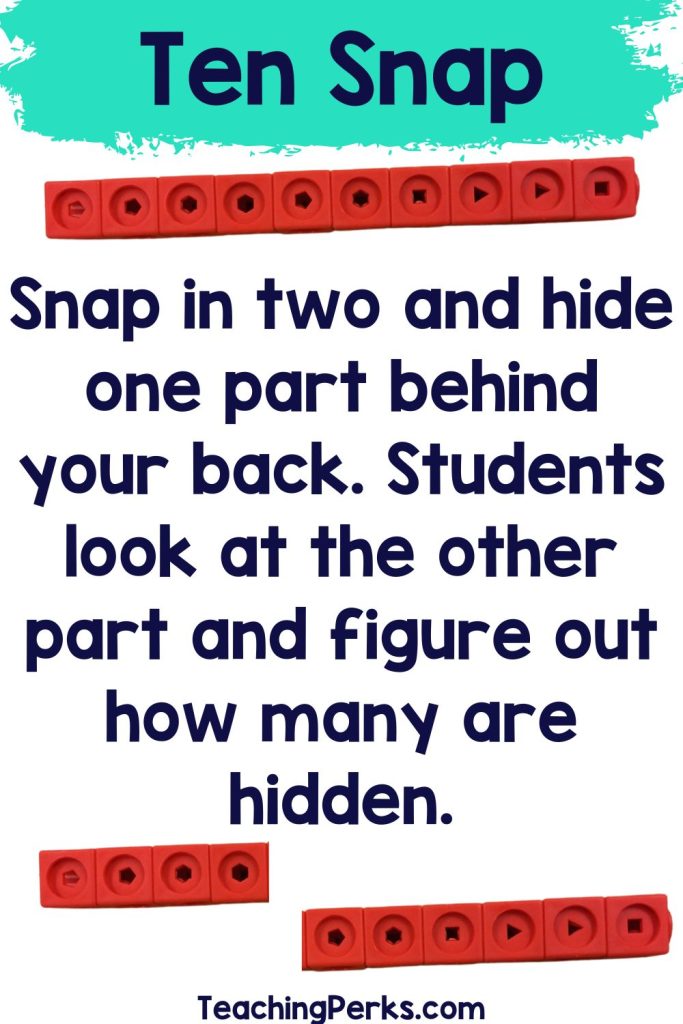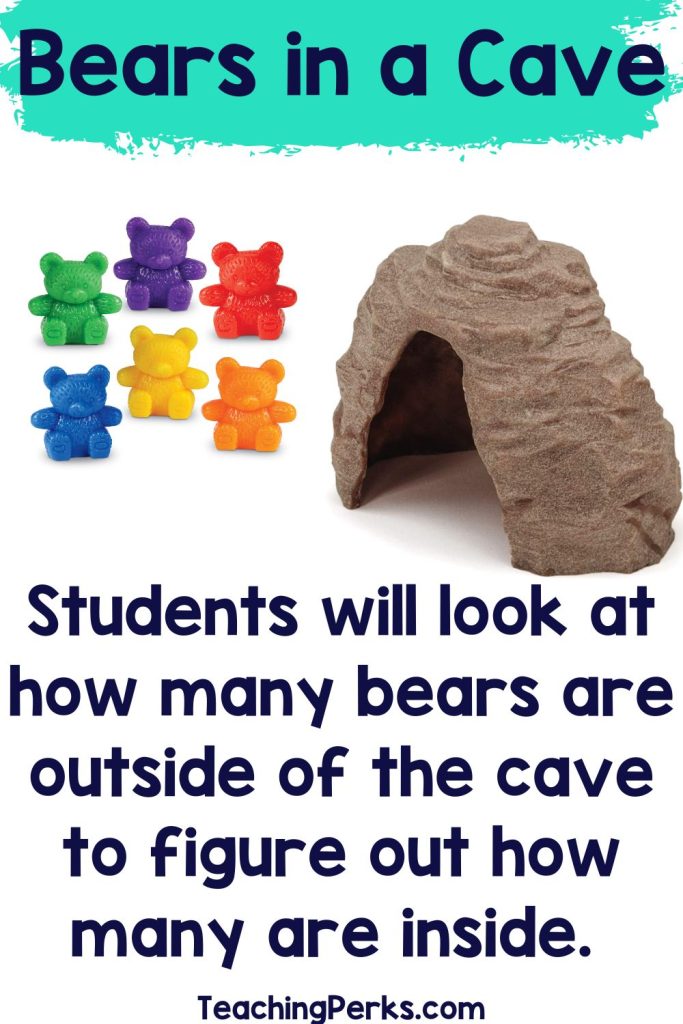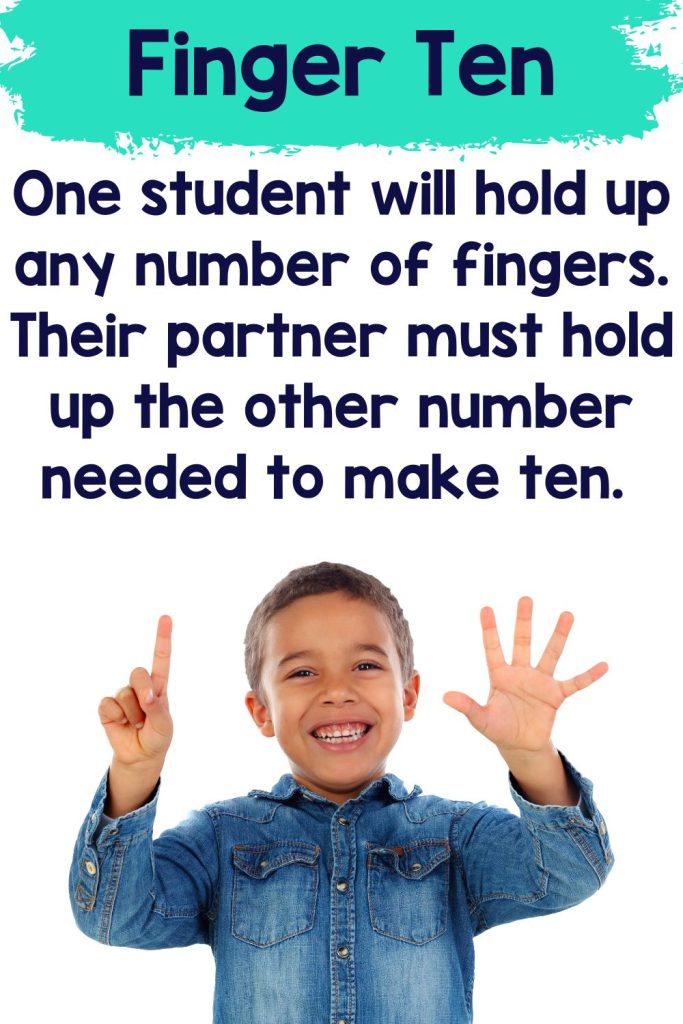With these fun activities and math games to teach ways to make 10, your students will be masters of this skill in no time! These games are a great way to get students practicing the important skill of number bonds and math facts in a fun way.

Make 10? Can’t you just add 10 more to the beginning of any number and call it good? As it turns out, teaching your 1st graders and other young children ways to make 10 and its partners can be quite tricky, especially if they have no idea what making 10 even means! But don’t worry—I’ve got your back! These fun hands-on learning activities and games will have your 1st grade students well on their way to mastering ways to make 10 by the end of the school year!

1) Ways to Make 10 Flip Over
One way you can teach making ten is by playing making ten flip over. This game teaches your students to quickly recognize the partners of ten in various ways. Plus, it’s a lot of fun for them too! All you need is a deck of cards with the face cards removed. To play the game, put the cards in a stack in the middle. Each player will flip over two cards from the top and put them faceup so that there are 4 cards in a line.
The players look at the cards and try to find two that make ten. If they can find two they keep those cards and put the rest on the bottom of the stack. If there is not a combination of ten then all cards go back to the bottom of the stack. The player with the most cards at the end is the winner!
2) Ten Frame Fill Up
Ten Frame Fill Up is a game that can help make a ten. Give students a ten frame or have them draw one on a white board. They will roll a die and cover up that many spots on the ten frame. If you have dice that go to 6 or 9 you can differentiate. They have to decide how many more they need to make a ten and add that many counters to the ten frame. Then they will need to write an addition equation to show their answer. It would be great to use two different color counters for this.
A variation of ten frame match up is a group game. Each student still has their own ten frame and dice. Each student rolls the dice to make a number to put on their ten frame. Now they roll again. Every student in the group rolls at the same time. This time then they can trade the number they roll with another player.
Example: Student A has 7 on their ten frame and student B has 5. Then student A rolls a 5 and student B rolls a 3 they can trade numbers. It’s a good idea to have a large number of students in the group playing so there are more opportunities to find a number you need.
3) Ten Snap
For this game you need 10 unifix cubes snapped together.
Put them behind your back and break the snapped cubes into two groups. Show one group to a student and they have to tell you how many you still have behind your back.
I love using this idea as an exit ticket for students to show they know different ways to make 10. You can do this game as kids line up and leave the room at dismissal or while waiting in line for lunch, special area, etc.!
For Example: You break the cubes into a group of 6 and 4. Show the student the group of 6 and they must tell you there are 4 behind your back.

4) Making Ten Memory
Use the numbers cards 1 – 9 from a set of playing cards Lay them out in an array and students will play a game of memory by flipping over two cards and trying to make a ten. This is a great game to give your students extra practice in matching different numbers when making ten.
5) Shake and Spill
I’m sure you have played this one but if not you will need red and yellow counters (or any two color counters you have). Students will need 10 each. They can put them in a cup or just their hands and shake and spill them on the table. They will record the number of red plus the number of yellow and write the addition equation. Super simple to shows ways to make 10 but kids love it!
6) Bears in a Cave
Have you ever played the game called Bears in a Cave to have students practice ways to make 10?
My students love this game. It is simple and best of all free.
I have a plastic cave from my son’s zoo set that I use but really you could use a paper cup, bowl or anything to represent the cave.
I also use counting bears but again you could use connecting cubes, beans, pennies, etc. as your bears.
Get ten “bears” and split them into two groups without the students seeing. Hide one group in the cave and the other group is out on the table for the students to see.
Students race to see who can figure out how many bears are in the cave.
Example: If you have 6 bears on the table students will need to say there are 4 bears in the cave because 6 + 4 = 10.

7) Make Ten Go Fish
Use number cards from a deck of playing cards. Give students cards (You can decide how many to give. I would start out with only 3 when just beginning). Students will ask another student if they have a certain number to make ten with one of the cards in their hand. If they have the card they must give it to that student and they get to lay it down as a match.
If the student does not have that number the other student must go fish by drawing a card from the stack. If they can make a ten with the number they draw and another card in their hand they get to lay it down. This card game will have students coming up with all sorts of ways to make 10 in no time!
8) Finger Ten
Students will play this with a partner. One student holds up a number with their fingers and the other partner must hold up the number of fingers that would make ten. This game is a hands-on opportunity for students to practice all the ways to make 10. The best thing about this game is it can be played anywhere around the school when you have some spare time.
Example) – If partner one holds up 7 fingers partner two must hold up 3 fingers.

9) Ways to Make 10 Bingo
Give students an empty Make 10 game board. You can get a copy of the make 10 game board for free here along with a make 10 practice page.
Ask them to fill in each box with a number 1 – 9. They can repeat numbers. The teacher will say a number and students must cover the number partner on their game board that would make a ten. This is a great game to play with the whole group or in math centers.
One of the best ways to play is to have students roll a die and cover the other number that goes with the number they roll to make a ten. I sometimes play this where they have to cover the whole board to win or the first to get 5 in a row depending on how much time we have to play. There are so many fun variations to this game!
Ways to Make 10 Conclusion
Learning ways to make 10 is a crucial skill for students to master in 1st grade. Knowing the partners for 10 will help them with so many other math skills.
Use games like the ones mentioned here or the ones discussed in this post about fun ways to use math activities to make math fun for students.
Need more fun ideas to teach math to your 1st graders? Get a year’s worth of differentiated lesson plans that cover all 1st grade common core standards. Let me take the stress of planning your next first grade math unit off of your plate!

Parent/Student workshop activity game needed for making bundles of ten.
This is some awesome thinking. Would you be interested to learn more? Come to see my website at QN9 for content about Airport Transfer.